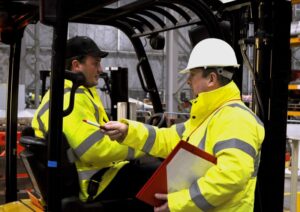Think about how much workplaces have changed, even in just the last 30 years. Whether we’re talking about the office, a construction site, a theme park or a hospital, emerging technologies, better manufacturing processes and automation has seen new equipment brought in to make our work more efficient. This equipment, from a tunnel-boring machine preparing the way for a new underground line, to the (now) humble laptop, often brings risk with it, says Adam Clarke, Managing Director (Consulting) at Praxis42.

Adam Clarke, Managing Director (Consulting), Praxis42.
And here’s the point: it’s every employer’s responsibility to ensure that any risk surrounding this equipment is assessed properly, and that it is used correctly to keep people safe.
That’s where PUWER comes in.
The PUWER landscape
PUWER stands for the Provision and Use of Work Equipment Regulations, more commonly known as the PUWER regulations. These all encompassing regulations strive to ensure that equipment provided at a workplace is suitable for the job, is in good working order, that people are trained to use it, and that it is safe to be used in the correct way.
I say all encompassing, because these regulations really do apply to almost every bit of equipment, machinery or even stationery that can be found in the workplace, from an office to an oil rig. So the PUWER Regulations apply as much to a stapler, chair or coffee machine, as they do to a bulldozer or chainsaw.
Despite these regulations, accidents involving work equipment are all too common. A report by the HSE shows that between 2016 and 2021, almost half (45%) of fatal injuries received at work in Great Britain were due to falling from a height (including cranes, cherry pickers and ladders) or being struck by a moving vehicle. As we continue down the list, it becomes clear that nearly all fatal injuries at work are connected to equipment.
At this point I want to stress that any workplace can be dangerous, so risk assessments should be part of any organisation’s management system, but accidents (and particularly fatal accidents) caused by equipment are most common in the construction, manufacturing and agriculture sectors, where there is more regular use of heavy machinery.
Read more: Workplace fatality figures released for 2021/22
What is covered by the PUWER Regulations?
That’s a tough question to provide a definitive answer to as PUWER is so wide ranging. No definitive list exists. We could talk about categories of equipment and exceptions, but the safest way to approach PUWER is to assume that everything in your organisation is covered, and to risk assess, inspect, maintain and train with that in mind.
It applies to both stationary and mobile equipment, whether the equipment is new or old, and whether your organisation owns or hires it. It even covers equipment that one of your employees owns, but with your permission, uses for work.
The only types of equipment not covered are those used by the public (so for example the compressed air machine at a petrol station). Instead, those are considered in the Health and Safety at Work etc Act 1974. Also note that many types of equipment are covered by additional regulations too, for example lifting equipment or PPE, and some kinds of equipment do require formal qualifications above and beyond work-based training (chainsaws for example).
Read more: PUWER: Provision and Use of Work Equipment Regulations
Helping to keep workers safe
The PUWER regulations set out a framework that can help employers keep workers safe in the workplace. By carrying out risk assessments, training, maintenance and inspections, people using equipment at work (and those around them) can feel more confident that they’re doing so safely.
If an accident does occur and an organisation was found to be seriously negligent, then fines and prison sentences are a very real outcome. Beyond the physical and emotional impact of an accident, there may be other additional consequences too. The HSE or Local Authority can also force the organisation to stop using the equipment for example, which can have a huge impact on operations.
So it’s in everybody’s interest to ensure that the PUWER regulations are followed in every workplace.
Training
 When equipment must be operated by people, then they will need to have instruction, training, and information about the equipment in order to operate it correctly. The level of training should be proportionate to risk and some equipment will not require any training.
When equipment must be operated by people, then they will need to have instruction, training, and information about the equipment in order to operate it correctly. The level of training should be proportionate to risk and some equipment will not require any training.
For work equipment involving a greater level of risk (for example a road breaker), then specific training must be provided to everybody using the equipment. Often this is a specialist need requiring an outside supplier. It is important to ensure that any training is delivered by a competent person and that training records are kept.
The right time to do this is when somebody new joins the team, or when they need to use equipment for the first time. Training will also need to be refreshed if the equipment changes, or if the processes involved change.
Inspections and maintenance
I’ve mentioned inspections and maintenance, but who exactly can fulfil these important tasks? As you may have guessed, it’s a competent person with the necessary skills, knowledge and experience.
Inspections are a more formal process that should be carried out when equipment is first installed and used. Regular inspections should also be carried out if equipment is used in adverse conditions that could cause it to deteriorate (in wet conditions for example), and after modifications and repairs.
Inspections not only identify equipment that isn’t working properly, but that isn’t working safely. This includes any guards, cut-offs and any other safety features that are part of the equipment’s operation. Without these, body parts can become caught in machinery, or moving parts or objects can fly from the equipment and hit people, resulting in serious injuries.
For many pieces of equipment, it may be fine to give it a quick visual once-over before using it. But for equipment that poses significant health and safety risks, a more detailed inspection including dismantling the equipment (according to the manufacturer’s instructions) may be required.
It’s a similar story for maintenance. How often and to what extent is driven by the equipment and the kind of use. Items on a construction site will need more care and attention than those found in an office.
You’ve got it covered
So look around your workplace. Almost everything you see should be considered covered by the PUWER regulations. That’s a lot of things to ensure are in good condition, are being used safely and are being inspected regularly. But we only need to remember that with over 50,000 serious injuries suffered in the workplace last year alone, it’s a task that should be at the top of the list.
The Safety Conversation Podcast: Listen now!
The Safety Conversation with SHP (previously the Safety and Health Podcast) aims to bring you the latest news, insights and legislation updates in the form of interviews, discussions and panel debates from leading figures within the profession.
Find us on Apple Podcasts, Spotify and Google Podcasts, subscribe and join the conversation today!


 When equipment must be operated by people, then they will need to have instruction, training, and information about the equipment in order to operate it correctly. The level of training should be proportionate to risk and some equipment will not require any training.
When equipment must be operated by people, then they will need to have instruction, training, and information about the equipment in order to operate it correctly. The level of training should be proportionate to risk and some equipment will not require any training.
Back to omissions, 1998 Provision and Use of Work Equipment Regulations to prevent stress related and physical injury through “reasonable adjustments” or since 2018 customising “Accessibility”.